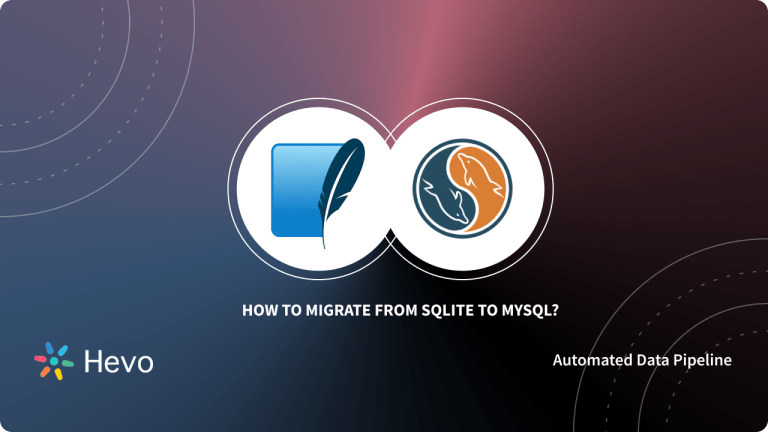SQLite and MariaDB are two of the most popular open-source relational databases, both using SQL to manage data. While SQLite is perfect for smaller databases, it’s a self-contained, serverless option that lacks the advanced features of a full SQL server. On the other hand, MariaDB is built for larger applications, offering more stability, additional storage engines, and better performance.
As your business grows, you might find that SQLite isn’t meeting your needs. That’s why migrating from SQLite to MariaDB is a smart move for better performance and more features. Just make sure to watch out for potential data type mismatches during the migration to ensure everything transfers smoothly.
This guide will walk you through the migration process step by step.
Table of Contents
SQLite Overview
SQLite is a self-contained, serverless, and lightweight relational database engine, perfect for smaller applications. It requires minimal setup, operates locally, and is ideal for embedded systems and mobile apps due to its simplicity and low resource consumption.
MariaDB Overview
MariaDB is an open-source, high-performance relational database management system that offers advanced features such as replication, clustering, and scalability. It is widely used for larger applications, providing robust support for high-concurrency environments and complex queries, making it suitable for enterprise-level systems.
Why do You Need to Connect SQLite to MariaDB?
- Scalability: SQLite is lightweight for small apps, but MariaDB handles larger datasets and more complex queries.
- Concurrent Access: SQLite struggles with multiple writes; MariaDB supports multiple concurrent reads/writes.
- Remote Access: SQLite is local-only; MariaDB supports client-server architecture for remote access.
- Advanced Features: MariaDB offers replication, clustering, and complex queries, which SQLite lacks.
- Backup & Recovery: MariaDB provides robust tools for backups and recovery, critical for large systems.
Facing challenges migrating your data to your desired destination? Migrating your data can become seamless with Hevo’s no-code intuitive platform. With Hevo, you can:
- Automate Data Extraction: Effortlessly pull data from 150+ sources( 60+ free sources).
- Transform Data effortlessly: Use Hevo’s drag-and-drop feature to transform data with just a few clicks.
- Seamless Data Loading: Quickly load your transformed data into your desired destinations.
Try Hevo and join a growing community of 2000+ data professionals who rely on us for seamless and efficient migrations.
Get Started with Hevo for FreeHow to Connect SQLite to MariaDB?
You now have a basic understanding of SQLite and MariaDB. This section will teach you how to connect SQLite to MariaDB. ESF Database Migration Toolkit is a powerful and high-performance toolkit for migrating data between database formats such as SQLite, MariaDB, and others.
This article explains how to use the ESF Database Migration Toolkit to quickly migrate data from SQLite to MariaDB! It will assist you in completing complex database migration tasks while saving you a significant amount of time!
Step 1: Export Data from SQLite
Run the following command to export data from SQLite:
sqlite3 yourdatabase.db .dump > database_dump.sql
Check the dump file to ensure it includes all your tables, indexes, and data.
Step 2: Prepare the SQL Dump File for MariaDB
SQLite and MariaDB have different schema and data types, therefore you need to transform the data before loading it to MariaDB.
- Open the SQL dump file in a text editor.
- Replace the SQLite-specific syntax with MariaDB-compatible syntax:
- Change ‘AUTOINCREMENT’ to ‘AUTO_INCREMENT‘.
- Replace INTEGER PRIMARY KEY with ‘INT AUTO_INCREMENT PRIMARY KEY‘.
- Remove or modify any SQLite-specific commands that are not supported by MariaDB.
Step 3: Create the Schema in MariaDB
- Log in to MariaDB using the command line or a database management tool.
mysql -u username -p
- Create a new Database.
CREATE DATABASE newdatabase;
USE newdatabase;- Finally, Import the modified SQL dump file:
mysql -u username -p newdatabase < database_dump.sql
Step 4: Verify Data Validity.
Check the data validity and correctness by running the command:
SELECT * FROM your_table LIMIT 10;
Limitations of Manually Connecting SQLite to MariaDB
The following are some of the drawbacks of manually connecting SQLite to MariaDB:
- Creating a Data Pipeline: Building an in-house Data Pipeline requires extensive experience, time, and manpower, as well as a high risk of error.
- Time-Consuming: Building a Data Pipeline in-house necessitates extensive experience, time, and manpower, as well as a high risk of error.
- Hard Coding: Analysts must write code and manage infrastructure, but they cannot access data within hours.
- Unreliable Application: Sometimes you’ll never know whether the 3rd party application is reliable or not.
Learn More:
Conclusion
In conclusion, migrating from SQLite to MariaDB provides greater scalability and performance for growing applications, but managing multiple data sources can be complex. Hevo Data simplifies this challenge with its no-code platform, enabling seamless data transfer between a variety of sources and destinations with just a few clicks.
Whether you’re dealing with large datasets or multiple databases, Hevo ensures a smooth and reliable data integration process. Additionally, with its flexible and unbeatable pricing plans, Hevo offers a solution tailored to your business needs, helping you save time and resources while maintaining data integrity across your systems. Sign up for a 14-day free trial and experience the feature-rich Hevo suite firsthand.
FAQ on SQLite to MariaDB
How to change SQLite to MariaDB?
– Export Data from SQLite
– Modify the SQL Dump
– Create a New Database in MariaDB
– Import the SQL Dump into MariaDB
Can you convert SQLite to MySQL?
Yes, you can convert SQLite to MySQL
Is MariaDB same as SQLite?
MariaDB and SQLite are different types of relational database management systems (RDBMS) and have distinct characteristics, use cases, and architectures.
Can SQLite and MySQL be used together?
Yes SQLite and MySQL can be used together








